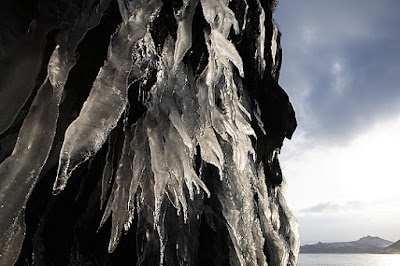King Eider (Somateria spectabilis) female and first year male

Notice that the male's bill is beginning to swell on top, as he is transforming into his more spectacular adult plumage.

Females and juveniles are almost indistinguishable among King eiders

King Eider breeding male

King Eiders are often found in flocks with Common Eiders and or/scoters. The breeding male is most distinctive and we have seen them much less frequently than the females and juveniles.
Eiders are of the family Anatidae and are further distinguished as diving (rather than dabbling) ducks. Diving ducks have legs placed far back on the body, a feature that helps to propel them when swimming and diving. They walk with difficulty, most require a running start to take off from the water.
Stellar's Eider (Polysticta stelleri)

The smallest eider, the Steller's Eider is restricted to northern latitudes where it breeds in freshwater tundra ponds. It spends the rest of the year in shallow marine waters. Birders rarely see it outside of Alaskan waters. They are usually seen in small flocks, diving synchronously for food. They rarely mix with other eiders. Currently their populations are declining and they are considered threatened in the United States.
Their wings make a whistling sound in flight and when we saw them last we were able to hear it!
Common Loon (Gavia immer)

Loons hunt primarily by sight and can dive to depths of 250 feet to catch their prey. During breeding season a family of loons can consume up to 2,000 lbs. of fish! Loons also have feet placed far back on their bodies and are especially cumbersome on land. For larger loons, such as this Common Loon (35 inches long), walking on land is nearly impossible and they push themselves along on their breasts when they have to breed.
"Migrating Common Loons occasionally land on wet highways or parking lots, mistaking them for rivers and lakes. They become stranded without a considerable amount of open water for a long takeoff. A loon may also get stranded on a pond that is too small."
They will molt into their more commonly thought of colors (white and black) starting in March.
Glaucous-winged Gull (Larus glaucescens)

Glaucous-winged gulls hybridize frequently with other gulls where their ranges overlap. In the Aleutians they overlap with Glaucous and Herring gulls. In more southern regions they hybridize quite often with Western gulls and in Washington the Western/Glaucous-winged hybrids are the most commonly found. This photograph, however, most closely resembles the Glaucous-winged Gull. We believe the darker gull is a juvenile.
The scene here is an example of kleptoparasitism or the stealing of food (particularly from flight). This is a common practice in food procurement. We frequently see gulls gathered around sea lions (above), harbor seals, land otters, and other birds trying to permanently borrow a piece of food.
Black Oystercatcher (Haematopus bachmani)


We have seen these very cool looking birds a few times in the past two weeks. Once at Stonewall and then farther south. Both times they were in groups of about 10-20 birds. They are found on rocky shores where they forage for mollusks, worms, crabs, barnacles, and echinoderms (sea stars, urchins, cucumbers...). Their brightly colored bills are used to pry, probe, hammer or stab their food. Males and females have differences in bill structure (females have longer bills) and individual oystercatchers can specialize as either hammerers or stabbers. Juvenile oystercatchers, such as the middle bird in this picture, have a dusky tipped bill.














































